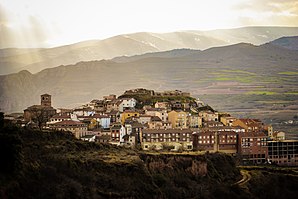Nalda
| Nalda parish | ||
|---|---|---|
 Nalda - town view with castle ruins (castillo)
|
||
| coat of arms | Map of Spain | |

|
|
|
| Basic data | ||
| Autonomous Community : |
|
|
| Province : | La Rioja | |
| Comarca : | Logroño (Comarca) | |
| Coordinates | 42 ° 20 ′ N , 2 ° 29 ′ W | |
| Height : | 630 msnm | |
| Area : | 24.6 km² | |
| Residents : | 1,023 (Jan 1, 2019) | |
| Population density : | 41.59 inhabitants / km² | |
| Postal code : | 26190 | |
| Municipality number ( INE ): | 26103 | |
| administration | ||
| Website : | Nalda | |
Nalda is a place and a municipality ( municipio ) with 1,023 inhabitants (as of January 1, 2019) in the autonomous community of La Rioja in northern Spain .
Location and climate
The place Nalda is located on the Río Iregua a good 17 km (driving distance) south of the provincial capital Logroño at an altitude of about 630 m . Soria , the capital of the Old Castilian province bordering the Rioja to the south , is located approx. 87 km south. The climate is temperate to warm; Rain (approx. 500 mm / year) falls mainly in the winter half-year.
Population development
| year | 1857 | 1900 | 1950 | 2001 | 2018 |
| Residents | 1,708 | 1,714 | 1,295 | 893 | 988 |
As a result of the mechanization of agriculture , the abandonment of small farms and the resulting lower demand for labor, the number of inhabitants in the mountain town has declined significantly since the beginning of the 20th century ( rural exodus ). The hamlet (pedanía) Islallana , which still has over 100 inhabitants, also belongs to the municipality .
economy
For centuries, the community was oriented towards agriculture for the purpose of self-sufficiency , with livestock farming (milk, cheese, meat) in the foreground. Today the place belongs to the Rioja wine region, but olives and vegetables are also grown. In addition, holiday apartments (casas rurales) are rented out, especially in the summer months .
history
Celtiberian , Roman , Visigoth and even Islamic-Moorish traces of settlement were not discovered in the municipality. The high-lying area served as summer pasture for sheep and goats for centuries . A military reconquest ( reconquista ) by the Christians did not take place, but the place was gradually settled as part of the Repoblación . Since around 1040 the area belonged to García Sánchez III. created manor (señorio) of the Tierra de Cameros . In the Middle Ages, the region was at times disputed between the kingdoms of Castile and Navarre . After the abolition of the manors in 1811, it belonged to the province of Soria and only came to the newly created province of Logroño in 1833, from which the region of La Rioja later emerged.
Attractions
- Nalda
- The ruins of the 13th / 14th Castillo de Nalda , built in the 13th century on the site of a predecessor, are located on the hilltop overlooking the place. The castle was the only one in the Tierra de Cameros . Excavation and restoration work took place in 2012/13.
- The Iglesia de Nuestra Señora de la Asunción , built in the 16th century - probably on the site of a previous demolished medieval building and with stones from the former city wall - is dedicated to the Assumption of Mary . It has a single nave, four bays and is comparatively high; Nave (nature) and vestibule are of vaults spans. It is possible that the altarpiece (retablo) still comes from the previous church; the smaller side reredos, however, are baroque .
- Surroundings
- The ruins of the Exconvento de San Antonio , built by the Franciscan Order between 1611 and 1617, are located approx. 1.5 km south of the village. The monastery was dissolved in 1835 as part of the dismortment of the church and monastery property and fell into disrepair.
- Nearby is the Ermita de Santa María de Villavieja , a manor-like building from the Baroque period.
- In the earth caves located approx. 2 km northeast of the village, whose original purpose can only be speculated (place of refuge, urn cemetery, early Christian monastery, etc.), in the 17th / 18th Pigeons settled.
- The largely destroyed dolmens Peña Guerra I and II are located in a wood about 4 km outside the village.
- Islallana
- The San Pedro church in the hamlet in front of a towering rock wall dates from the 16th century.
Web links
- Valle del Iregua - Photos + Quick Facts (Spanish)
Individual evidence
- ↑ Cifras oficiales de población resultantes de la revisión del Padrón municipal a 1 de enero . Population statistics from the Instituto Nacional de Estadística (population update).
- ↑ Nalda - climate tables
- ↑ Nalda - Population Development
- ↑ Nalda - History
- ↑ Nalda - Castle
- ↑ Nalda - Church
- ↑ Nalda - Exconvento de San Antonio
- ↑ Nalda - Ermita
- ↑ Nalda - Dovecotes
- ↑ Nalda - Dolmen


